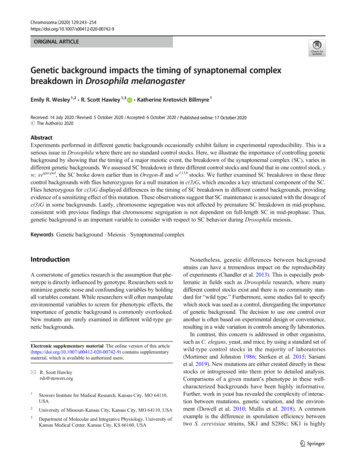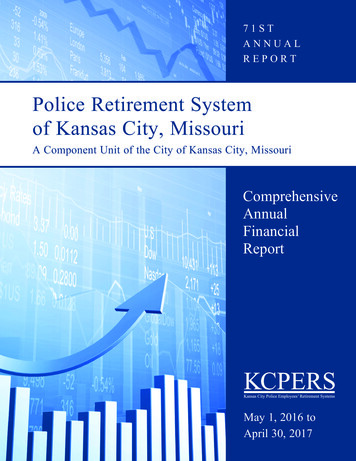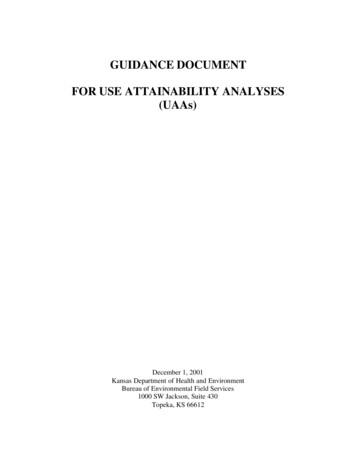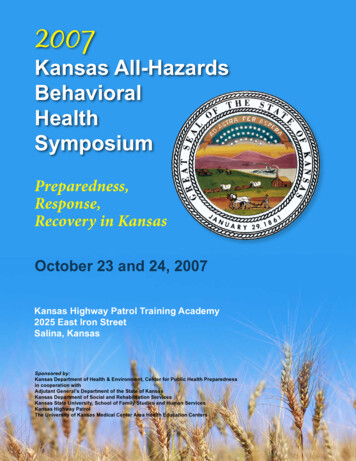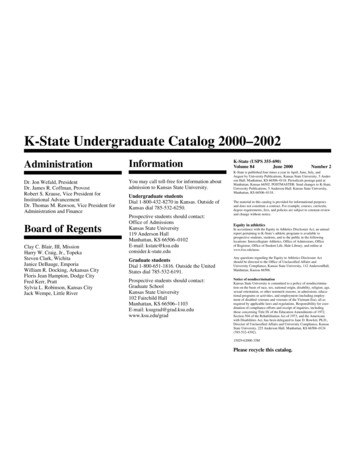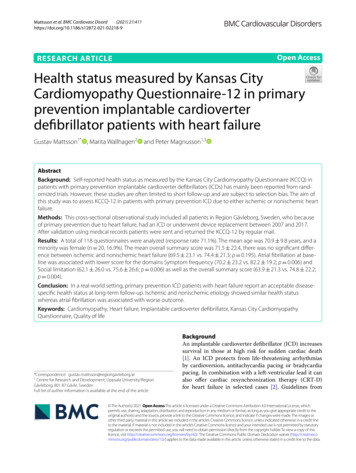
Transcription
(2021) 21:411Mattsson et al. BMC Cardiovasc en AccessRESEARCH ARTICLEHealth status measured by Kansas CityCardiomyopathy Questionnaire‑12 in primaryprevention implantable cardioverterdefibrillator patients with heart failureGustav Mattsson1* , Marita Wallhagen2and Peter Magnusson1,3AbstractBackground: Self-reported health status as measured by the Kansas City Cardiomyopathy Questionnaire (KCCQ) inpatients with primary prevention implantable cardioverter defibrillators (ICDs) has mainly been reported from randomized trials. However, these studies are often limited to short follow-up and are subject to selection bias. The aim ofthis study was to assess KCCQ-12 in patients with primary prevention ICD due to either ischemic or nonischemic heartfailure.Methods: This cross-sectional observational study included all patients in Region Gävleborg, Sweden, who becauseof primary prevention due to heart failure, had an ICD or underwent device replacement between 2007 and 2017.After validation using medical records patients were sent and returned the KCCQ-12 by regular mail.Results: A total of 118 questionnaires were analyzed (response rate 71.1%). The mean age was 70.9 9.8 years, and aminority was female (n 20, 16.9%). The mean overall summary score was 71.5 22.4, there was no significant difference between ischemic and nonischemic heart failure (69.5 23.1 vs. 74.4 21.3; p 0.195). Atrial fibrillation at baseline was associated with lower score for the domains Symptom frequency (70.2 23.2 vs. 82.2 19.2; p 0.006) andSocial limitation (62.1 26.0 vs. 75.6 26.6; p 0.006) as well as the overall summary score (63.9 21.3 vs. 74.8 22.2;p 0.004).Conclusion: In a real-world setting, primary prevention ICD patients with heart failure report an acceptable diseasespecific health status at long-term follow-up. Ischemic and nonischemic etiology showed similar health statuswhereas atrial fibrillation was associated with worse outcome.Keywords: Cardiomyopathy, Heart failure, Implantable cardioverter defibrillator, Kansas City CardiomyopathyQuestionnaire, Quality of life*Correspondence: gustav.mattsson@regiongavleborg.se1Centre for Research and Development, Uppsala University/RegionGävleborg, 801 87 Gävle, SwedenFull list of author information is available at the end of the articleBackgroundAn implantable cardioverter defibrillator (ICD) increasessurvival in those at high risk for sudden cardiac death[1]. An ICD protects from life-threatening arrhythmiasby cardioversion, antitachycardia pacing or bradycardiapacing. In combination with a left-ventricular lead it canalso offer cardiac resynchronization therapy (CRT-D)for heart failure in selected cases [2]. Guidelines from The Author(s) 2021. Open Access This article is licensed under a Creative Commons Attribution 4.0 International License, whichpermits use, sharing, adaptation, distribution and reproduction in any medium or format, as long as you give appropriate credit to theoriginal author(s) and the source, provide a link to the Creative Commons licence, and indicate if changes were made. The images orother third party material in this article are included in the article’s Creative Commons licence, unless indicated otherwise in a credit lineto the material. If material is not included in the article’s Creative Commons licence and your intended use is not permitted by statutoryregulation or exceeds the permitted use, you will need to obtain permission directly from the copyright holder. To view a copy of thislicence, visit http:// creat iveco mmons. org/ licen ses/ by/4. 0/. The Creative Commons Public Domain Dedication waiver (http:// creat iveco mmons. org/ publi cdoma in/ zero/1. 0/) applies to the data made available in this article, unless otherwise stated in a credit line to the data.
Mattsson et al. BMC Cardiovasc Disord(2021) 21:411the European Society of Cardiology (ESC) recommend aprimary prophylactic ICD for patients with symptomaticheart failure with New York Heart Association functional classification (NYHA-class) II–III, left ventricularejection fraction 35% despite at least three months ofoptimal medical therapy, and a life expectancy of at least1 year with good functional status [1].Patient reported outcome measures through questionnaires have been increasingly used in research settings[3]. In patients with heart failure, the Kansas City Cardiomyopathy Questionnaire (KCCQ) offers a diseasespecific measurement of health status and health-relatedquality of life [4]. The 12-item KCCQ, the KCCQ-12preserves the psychometric properties of the originalquestionnaire, shows high correlation with the originalscales ( 0.93 for all scales in all clinical settings), hightest–retest reliability ( 0.76 for all domains), and highresponsiveness to clinical change [5]. The KCCQ, as wellas KCCQ-12 correlate with physician assessed NYHAclass as well as heart failure outcomes [4–6].The primary aim of this study was to, with a cross-sectional observational design, assess self-reported healthstatus as measured by the KCCQ-12 in an unselectedcohort of patients with primary prevention ICD due toischemic or nonischemic heart failure without tertiarycenter bias. The secondary aims were to assess whetherself-reported health status as measured by the KCCQ12 were affected by etiology of heart failure (ischemic vsnonischemic), atrial fibrillation before implant, age, sex,complications requiring surgery, and appropriate therapyor inappropriate shock.MethodsData collection and validityThis cross-sectional observational study includedpatients from Region Gävleborg in Sweden who,because of primary prevention due to heart failure, hadan ICD implanted or who underwent device replacement between 1st January 2007 and 1st of January 2017.Patients were identified from a retrospective observational study. Long-term outcome with regard to appropriate therapy, inappropriate shock, complications requiringsurgery, mortality, and cause of death in this cohort haspreviously been reported [7]. Information about baseline characteristics as well as appropriate therapy, inappropriate shock, complications requiring surgery, andmortality at long-term follow up had been retrieved fromelectronic medical records (Melior , Cerner Sverige AB,Stockholm) between March 2017 and February 2018. Eligible patients with primary prevention ICD due to heartfailure who had a Swedish postal address were sent andreturned a Swedish version of the KCCQ-12 by regularmail during 2019.Page 2 of 8The KCCQ‑12In the KCCQ-12, responses are given on a Likert scalethat for each individual item is scored on a scale of0–100 with higher scores indicating better health.Items are grouped into the four domains; Physical limitation, Symptom frequency, Quality of life, and Sociallimitation. The score of each domain is calculated asthe average of its constituent items. In case of missingvalues for an item, the score of that item is consideredto be the same as the average of the other items in itsdomain. An overall summary score is calculated as theaverage of all four domains.Statistical analysesData were described as frequencies, percentages, andmeans including standard deviations ( ). The t-test wasused for comparisons of normally distributed continuous variables. The Mann–Whitney U-test was used fornon-normally distributed continuous variables. TheShapiro–Wilk test was used to test for the normality distribution of data. The chi-squared test was usedfor comparisons of categorical variables. Differencesin KCCQ-12 domains and summary scores betweengroups were tested with Mann–Whitney U-test. Theassociations between age and KCCQ-12 were testedusing Spearman’s rank-order correlation. Kruskal–Wallis non-parametric analysis of variance was used to analyze differences between the age strata; 32–59 years,60–69 years, 70–79 years, and 80 years. The magnitude of difference in KCCQ-12 domains or summaryscore between groups was reported as the differencebetween the means. Two-sided p values 0.05 wereconsidered statistically significant. The software programs Excel 2010 (Microsoft Corporation, Redmond,WA), SPSS version 22 (IBM, Armonk, NY) were usedfor analyses.ResultsResponse rate and dropout analysisOut of 236 patients identified with primary preventionICD implantation due to heart failure, 169 were still aliveat the time of health status assessment. Out of these 169patients, 166 had a Swedish postal address and weresent the KCCQ-12 by regular mail including a pre-paidreturn envelope. The questionnaire was returned by 123patients, in 118 of these all domains could be calculated.Figure 1 depicts the process for deriving the final sample for analysis. The response rate was 71.1%. The age ofthose that returned complete questionnaires was similarto those that did not (70.9 9.8 vs. 67.0 12.45 years;p 0.062). The proportion of females was lower among
Mattsson et al. BMC Cardiovasc Disord(2021) 21:411Page 3 of 8Fig. 1 Flow-chart depicting the process for deriving the final sample for analysisthose who returned a complete questionnaire than forthose that did not (16.9% vs. 22.9%; p 0.001).Cohort characteristics at ICD implantationThe baseline characteristics of the sample (n 118) atICD implantation are summarized in Table 1. The meanage at ICD implantation was 65.0 10.4 years. A minority was female (n 20, 16.9%). The mean age at the timeof the survey was similar between females and males(71.2 7.8 vs. 70.9 10.1 years; p 0.904). Almost halfof the patients had a CRT-D at first implantation (n 57,48.3%). A majority of patients had ischemic etiology(n 69, 58.5%) and patients with ischemic etiology wasolder than patients with nonischemic etiology (73.3 8.1vs. 67.6 10.9; p 0.005). Patients who had atrial fibrillation at baseline were older at the time of the survey thanthose that did not (74.4 8.1 vs. 69.5 10.1; p 0.013).Cohort characteristics at follow‑upIn the final sample, of the 118 patients, the mean timebetween ICD implantation and follow-up with KCCQ12 was 5.9 2.3 years. The mean time from ICD implantation to evaluation of baseline characteristics andoutcomes such appropriate therapy, inappropriate shock,and complications requiring surgery was 4.1 2.4 years.Out of these 118 patients; 16 (13.6%) experiencedTable 1 Characteristics at ICD implant of the 118 patientsanalyzed regarding KCCQ-12n (%)Patients118Mean age at implant (years)65.0 10.4Mean age at KCCQ (years)FemalesIschemic etiology70.9 9.820 (16.9)69 (58.5)Device typeICD-VR16 (13.6)ICD-DR45 (38.1)CRT-D57 (48.3)Hypertension54 (45.8)Diabetes mellitus27 (22.9)Renal failure*16 (13.6)Atrial fibrillation35 (29.7)Beta-blockers106 (89.8)ACE-i/ARB111 (94.1)MRA75 (63.6)Data presented as frequencies (percentage in parenthesis)ACE-i angiotensin converting enzyme inhibitor, ARB angiotensin receptorblockers, CRT-D cardiac resynchronization therapy defibrillator, ICD-DR duallead implantable cardioverter defibrillator, ICD-VR single lead implantablecardioverter defibrillator, KCCQ-12 12-item Kansas City CardiomyopathyQuestionnaire, MRA mineralcorticoid receptor antagonists*Defined as S-Creatinine 130 μmol/L
Mattsson et al. BMC Cardiovasc Disord(2021) 21:411Page 4 of 8appropriate ICD therapy (defined as antitachycardia pacing or cardioversion of ventricular tachyarrhythmia), 5(4.2%) experienced inappropriate shock (defined as cardioversion in the absence of ventricular tachyarrhythmia),and 16 (13.6%) experienced at least one complicationrequiring surgical intervention. The mean age was similarfor those that experienced appropriate therapy vs thosethat did not (72.9 8.1 vs. 70.6 10.0 years; p 0.376),for those that experienced inappropriate shock vs thosethat did not (73.4 8.4 vs. 70.8 9.8; p 0.563), and forthose that experienced complications requiring surgeryvs those that did not (74.7 8.2 vs. 70.3 9.9; p 0.099).Health status measured by KCCQ‑12The results for the four domains and the summary scoreof the KCCQ-12, for all patients as well as for patientswith heart failure of ischemic and nonischemic etiology isgiven in Table 2. The mean of the overall summary scorefor all patients was 71.5 22.4. There was no statisticallysignificant difference between ischemic and nonischemicheart failure (69.5 23.1 vs. 74.4 21.3; p 0.195) withregards to the overall summary score, nor was thereany statistically significant difference for any domain. InTable 2 the results of the four domains and the summaryscore are presented for patients with ICD-VR or ICD-DRas compared to patients with CRT-D. The overall summary score was lower in patients with CRT-D comparedto ICD-VR/DR (67.7 22.4 vs. 75.1 22.0; p 0.041).Patients with CRT-D reported lower scores in thedomain Symptom frequency (74.8 21.2 vs. 82.3 20.5;p 0.040).AgeThere was a negative correlation between age at thetime of the survey and overall summary score (Spearman’s correlation coefficient, rS 0.186; p 0.043),Physical limitation ( rS 0.230; p 0.012), and Symptom frequency ( rS 0.252; p 0.006). But no correlation between age and the Quality of life (p 0.418) orSocial limitation (p 0.192) domains.The KCCQ-12 scores for the age strata; 32–59 years,60–69 years, 70–79 years, and 80 years as well as theresult of the Kruskal–Wallis tests are shown in Table 3.There was a significant effect of age strata upon Symptom frequency (p 0.046). However, for the youngestage strata, scores for this domain was slightly lower(80.1 22.1) than for the second youngest age strata(84.7 19.7), while after that scores decreased withincreasing age with age strata 70–79 years scoring75.7 19.6 and age strata 80 years 72.5 23.8. Therewas no statistically significant difference between theage strata for Physical limitation, Quality of life, orSocial limitation.SexThere was no significant difference between femalesand males for the overall summary score (71.1 24.2vs. 71.6 22.1; p 0.919) or for any of the separatedomains; Physical limitation (p 0.679), Symptom frequency (p 0.455), Quality of life (0.858, or Social limitation (p 0.992).Table 2 Mean score of the KCCQ-12 in 118 patients with primary prevention ICD due to heart failureKCCQ-12Physical limitationSymptom frequencyQuality of lifeSocial limitationOverall summary scoreKCCQ-12Physical limitationSymptom frequencyQuality of lifeSocial limitationOverall summary scoreAlln 118Mean score68.0 26.478.6 21.169.7 25.771.6 27.071.5 22.4Alln 118Mean score68.0 26.478.6 21.169.7 25.771.6 27.071.5 22.4Ischemic HFn 69Mean score64.6 26.277.2 21.568.8 25.768.8 27.169.5 23.1ICD-VR/DRn 61Mean score72.0 23.382.3 20.573.2 25.275.0 27.575.1 22.0Nonischemic HFn 49Mean score72.8 26.180.6 20.570.9 25.875.6 26.774.4 21.3CRT-Dn 57Mean score63.7 28.974.8 21.266.0 25.968.0 26.367.7 22.4Ischemic versusnonischemic HFp value0.0620.3050.5820.1440.195ICD-VR/DRversus CRT-Dp value0.1580.0400.0930.0960.041Statistically significant p-values are given in boldComparisons are made between ischemic versus nonischemic HF and VR/DR versus CRTDCRT-D cardiac resynchronization therapy defibrillator, HF heart failure, ICD implantable cardioverter defibrillator, ICD-VR/DR single or dual lead implantablecardioverter defibrillator, KCCQ-12 12-item Kansas City Cardiomyopathy Questionnaire, SD standard deviation
Mattsson et al. BMC Cardiovasc Disord(2021) 21:411Page 5 of 8Table 3 KCCQ-12 score in 118 patients with primary prevention ICD due to heart failure stratified by ageKCCQ-1232–59 years (n 10)60–69 years (n 42)70–79 years (n 42) 80 years (n 24)Kruskal–Wallis testMean scorep value75.8 8.171.7 24.967.5 26.759.0 27.50.16466.3 28.372.9 27.267.3 24.469.8 25.00.52068.2 23.00.402Mean scorePhysical limitationSymptom frequencyQuality of lifeSocial limitationOverall summary score80.1 22.182.5 22.775.6 22.6Mean score84.7 19.772.0 28.174.4 22.9Mean score75.7 19.670.1 25.169.6 21.772.5 23.80.04669.1 30.40.564Statistically significant p-values is given in boldICD implantable cardioverter defibrillator, KCCQ-12 12-item Kansas City Cardiomyopathy QuestionnaireSubgroup analysis of the KCCQ‑12Subgroup analyzes for atrial fibrillation, appropriatetherapy, inappropriate shock, and complications requiring surgery are shown in Table 4. Patients with a historyof atrial fibrillation before ICD implant had at followup significantly lower score for the domains Symptomfrequency (70.2 23.2 vs. 82.2 19.2; p 0.006) andSocial limitation (62.1 26.0 vs. 75.6 26.6; p 0.006)as well as the overall summary score (63.9 21.3 vs.74.8 22.2; p 0.004), but there was no statisticallysignificant difference in the scores for the domainQuality of life (p 0.119). However, for the domainPhysical limitation there was a trend toward significance (p 0.051) with atrial fibrillation patients having lower scores (61.0 27.3 vs. 70.9 25.6). Patientswith and without a history of appropriate therapy orcomplications requiring surgery had similar scores onall KCCQ-12 domains and the overall summary score.There were few patients who had received inappropriate therapy (n 5). Patients who had received inappropriate therapy had significantly lower scores for boththe domain Social limitation (43.3 19.0 vs. 72.5 22.1;p 0.015) and the overall summary score (50.7 19.0vs. 72.5 22.1; p 0.031), but there was no statisticallysignificant differences in the domains Physical limitation, Symptom frequency, or Quality of life.DiscussionIn real-world primary prevention ICD cohorts, KCCQ12 scores might be lower than in cohorts reported fromrandomized trials. However, KCCQ-12 scores in thispopulation considering the long-term follow-up appearto be generally acceptable, indicating selection of patientswith high functional status at implantation. A change ofat least 5 points in KCCQ-12 scores is usually consideredto be the minimal clinically important difference [5, 8].The short form of the KCCQ, the KCCQ-12 was created as a tool for easier implementation into clinicalpractice and preserves the psychometric properties ofthe original KCCQ [5]. For this reason, the KCCQ-12was used in this study, however this makes comparisons to some studies more difficult. In the MulticenterAutomatic Defibrillator Implantation Trial With CardiacResynchronization Therapy (MADIT) trial, health status was measured with the KCCQ, due to reporting ofall separate domains, an approximation of the KCCQ-12overall summary score can be calculated [9]. At inclusion the mean of the overall summary score for the 675patients with only ICD was 75.2 for all KCCQ domainsand 75.1 for all KCCQ-12 domains, for the 1024 patientswith CRT-D the mean of the overall summary score was75.6 for all KCCQ domains and 75.4 for all KCCQ-12domains [9]. This demonstrates how similar the overallTable 4 Subgroup analyses of KCCQ-12 scores in 118 patients with primary prevention ICD due to heart failureKCCQ-12Physical limitationSymptom frequencyQuality of lifeSocial limitationOverall summary scoreAtrial fibrillationn 35Appropriate therapyn 16Inappropriate shockn 5Complicationsn 16Mean differenceMean differencep valueMeandifferencep valueMean differencep value 10.0 17.0 18.00.168 21.80.0519.90.238 12.00.0062.40.946 8.20.1190.70.795 13.50.0063.90.958 10.90.0043.60.841p value0.1874.50.782 18.60.098 0.40.8642.50.898 29.60.0151.50.9300.0312.00.925Statistically significant p-values are given in boldPositive mean difference indicates higher valuesICD implantable cardioverter defibrillator, KCCQ-12 12-item Kansas City Cardiomyopathy Questionnaire
Mattsson et al. BMC Cardiovasc Disord(2021) 21:411summary score is for KCCQ and KCCQ-12, in a population with primary prevention ICD due to heart failure,the removal of the domains symptom stability and symptom burden does not affect the overall summary score.The MADIT included patients with left ventricularejection fraction 30% but only NYHA class I–II. Atfollow-up after three years, the mean KCCQ overall summary score for left bundle branch block patients solelywith ICD was 80.0 and for patients with CRT-D was 83.4[9]. Both higher than the mean KCCQ-12 overall summary score of 71.5 in our cohort after a mean follow-upof 5.9 years. This is partly explained by the inclusion ofonly NYHA class I–II in the MADIT while primary prevention ICD guidelines recommend implantation of anICD for NYHA II–III [1]. In the MADIT patients wererandomized to the intervention of CRT-D implantation and CRT-D was shown to increase KCCQ scores.In our study, patients where not randomized to CRT-D.In real world cohorts patients with more severe symptoms might be more prone to receive CRT-D. This likelyexplains why patients with CRT-D had lower KCCQscores in our cohort.In the Danish Study to Assess the Efficacy of Implantable Cardioverter-Defibrillators (DANISH) trial heartfailure patients were randomized to either ICD or usualclinical care and health status was measured using theMinnesota Living with Heart Failure Questionnaire(MLHFQ) [10]. After 32 months the change in meanMLHFQ overall score was similar between the ICD andcontrol group (p 0.82). Probably differences betweenheart failure patients with and without primary prevention ICD are primarily not caused by ICD implantationbut rather by the selection process.Page 6 of 8showed a small negative effect (mean difference 5.5per 10-year increment, adjusted for sex and ethnicity) of age upon KCCQ overall summary score for thosepatients who are 70 years while this was not seen forpatients 70 years of age [11].SexThe proportion of females was notably low (16.9%), thiswas partly due to females in our cohort being somewhat less likely to return the questionnaire as was seenin the drop-out analysis with chi-squared test (p 0.001),but also due to a low proportion of females among eligible participants for the study in the cohort of primaryprevention ICD patients (22.9%). The low proportionof females in primary prevention ICD cohorts is wellknown, in one study with pooled data from eleven European national registries the proportion of females was18.7% [12]. In our study sex category had no effect onany of the KCCQ-12 domains or overall summary score.In heart failure, differences between the sexes in healthrelated quality of life and health status are controversial.While results of many studies have been heterogeneous, some have reported lower KCCQ scores in femalethan in male heart failure patients, independently fromother clinical factors [11, 13]. The reason for lower proportions of women in ICD cohorts is unclear, femaleswith primary prevention ICD has been shown to havea lower mortality and lower risk of appropriate therapythan males [12]. Therefore, sex differences in heart failurehealth status or health-related quality of life, if any exist,might differ between general heart failure populationsand primary prevention ICD cohorts.Appropriate therapyAgeThere were moderate correlations between age and theKCCQ-12 domains Physical limitation, Symptom frequency, and the overall summary score. This was strongest for Symptom frequency (rS 0.252), that also wasthe domain that showed significant differences betweenthe prespecified age strata. It is likely that Quality of lifeand Social limitation, domains that did not show statistically significant correlations with age, reflects moreof a subjective interpretation of health-related qualityof life, while domains such as Physical limitation andSymptom frequency reflect more of an objective assessment of heart failure specific health status that is moreage-dependent. It is also likely that physicians offer allyounger patients that fulfill guideline criteria a primaryprevention ICD, while for older patients there is a selection, where those patients who have higher health-relatedquality of life are more likely to have an ICD implanted.A large study of outpatient heart failure patientsPrevious prospective observational studies have identified ICD shocks as a factor decreasing health-relatedquality of life and physical activity as well as increasing anxiety [14]. In our study no significant associationbetween appropriate therapy and health status measuredby the KCCQ-12 was seen. In the PainFree SST clinicaltrial, anxiety remained increased for the 24 month follow-up after a shock, reduction in daily activity was seenbut returned to normal after 3 months [14]. Our patientswith a longer time with an ICD (5.9 2.3 years) mightreflect a population in which health status no longer isaffected by previous ICD therapy. However, the lack of astatistically significant association between appropriatetherapy and health status might also be due to our lowersample size resulting in a type II error.
Mattsson et al. BMC Cardiovasc Disord(2021) 21:411Inappropriate shockInappropriate therapy reached the significance level forthe Social limitation domain and the overall summaryscore. While it was clear that this subgroup in our cohortscored generally worse (difference in mean overall summary score 21.8), the number of patients in this subgroup was small (n 5). Due to this, the magnitude ofdecrease in KCCQ-12 score is uncertain. However, several mechanisms that could lead to lower health status inthese patients exist, such as anxiety after painful shocksor them serving as a marker of rapid atrial fibrillation,the most common reason for inappropriate shocks [15].It has been shown that inappropriate shocks due to atrialfibrillation, but not due to lead failure, are associatedwith increased all-cause mortality [15].Atrial fibrillationIn our cohort, a history of atrial fibrillation before ICDimplant predicted significantly lower KCCQ-12 scoresat follow-up (difference in mean overall summaryscore 10.9). There was a statistically significant reduction of similar size in both Symptom frequency andSocial limitation, as well as a trend toward the same inother domains. Atrial fibrillation is associated withmarked decreases in health-related quality of life [16]. Inpatients with heart failure and concomitant atrial fibrillation, therapy with catheter ablation improves healthrelated quality of life as well as heart failure specifichealth status measured by the MLHFQ [17]. The association between atrial fibrillation and lower health status asmeasured by the KCCQ-12 in heart failure patients couldbe due to atrial fibrillation being more common in severeheart failure, atrial fibrillation leading to a deteriorationof left ventricular systolic function over time, or atrialfibrillation and heart failure both contributing to the burden of disease in ways that the KCCQ-12 cannot discriminate between [18].Complications requiring surgeryThere were no statistical differences in any domain or inthe KCCQ-12 overall summary score. Lead-related problems are the most common complications that requiresnew surgery, after 10 years 25% of leads have beenaffected by complications [19]. In our whole ICD cohort,lead dislodgement or lead dysfunction constituted 60%of complications requiring surgery [7]. Therefore, whileKCCQ-12 scores predict several outcomes, it is likely thatlead-related complications depend more on lead-relatedfactors rather than health status. In one study on patientswith an ICD and hypertrophic cardiomyopathy, complications requiring surgery did not affect health-relatedPage 7 of 8quality of life measured by the SF-36 [20]. However, inthat study as well as in the current study, follow-up timewas long, it is plausible that complications requiring surgery would affect health status in the short term. Thisshould be evaluated in future trials.Strengths and weaknessesThis cross-sectional observational study provides realworld data regarding KCCQ-12 scores in an unselectedcohort of patients with primary prevention ICD due toheart failure with long-term follow-up. All patients andvariables have been validated from electronic medicalrecords by physicians. The total number of patients wasrelatively low making interpretation more difficult. Fewpatients in some subgroups make some of the subgroupanalyses prone to type I and II error. While the responserate of 71% was considered acceptable, 29% of patientsdid not return the questionnaire thus there is a risk ofselection bias. Our study shares the limitation of a lowproportion of females seen in numerous ICD cohorts. Itis unknown to which extent geographical differences inthe ICD management within a country matters and ifinterpretations can be generalized to other countries.Clinical perspectiveThis observational pragmatic study demonstrates apatient-reported health status which is lower than insome prospective studies including randomized controlled trials. Still, this study indicates an acceptablehealth status in long-term survivors after ICD-implant.The selection of ICD candidates seems to be adequateas the health status likely can be translated into moderate burden of symptoms. Nevertheless, this study highlights the importance of optimal medical management.Therefore, modern optimal heart failure medicationand structured clinical care is warranted in addition todevice follow-up.ConclusionsIn a real-world pragmatic setting, primary preventionICD patients with heart failure report an acceptabledisease-specific health status according to KCCQ-12 atlong-term follow-up. Ischemic and nonischemic underlying etiology showed similar health status whereasatrial fibrillation was associated with worse outcome.AbbreviationsCRT-D: Cardiac resynchronization therapy defibrillator; ESC: European Societyof Cardiology; ICD: Implantable cardioverter defibrillator; KCCQ: Kansas CityCardiomyopathy Questionnaire; KCCQ-12: 12-Item Kansas City Cardiomyopathy Questionnaire; MLHFQ: Minnesota Living with Heart Failure Questionnaire;NYHA class: New York H
age at ICD implantation was 65.0 10.4 years. A minor - ity was female (n 20, 16.9%). e mean age at the time of the survey was similar between females and males (71.2 7.8 vs. 70.9 10.1 years; p 0.904). Almost half of the patients had a CRT-D at rst implantation (n 57, 48.3%). A majority of patients had ischemic etiology





